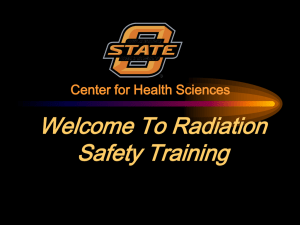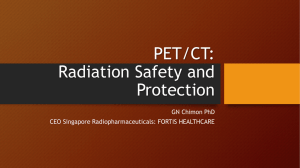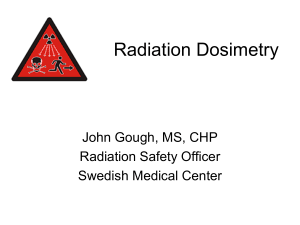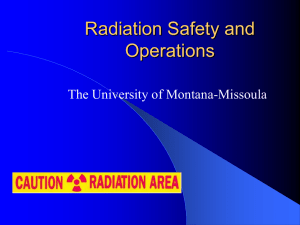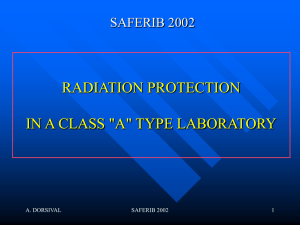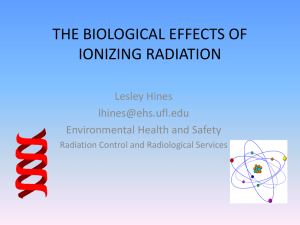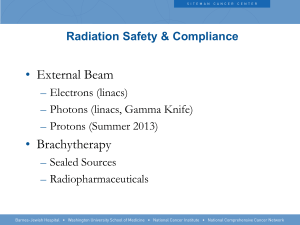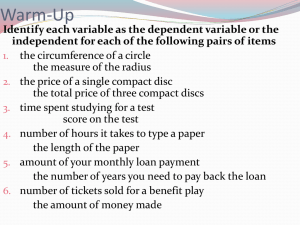108RadSafety - Physics @ UIC - University of Illinois at Chicago
advertisement
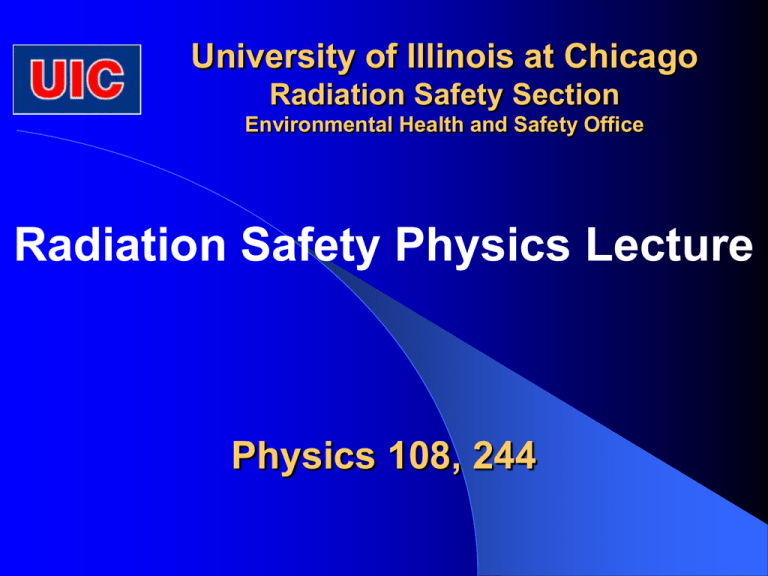
University of Illinois at Chicago Radiation Safety Section Environmental Health and Safety Office Radiation Safety Physics Lecture Physics 108, 244 Ionizing Radiation Radiation that can cause ionization of the material through which it passes either directly or indirectly Electromagnetic radiation Particulate radiation Electromagnetic Radiation Electro-magnetic waves (uncharged packets of energy) propagated through space or a material medium Wavelength, m Frequency, s-1 _ 1 E~ν~λ Energy of one photon, eV Particulate Radiation Matter that that is propagated through space or through a material medium Alpha Particles Beta Particles (Electrons, Positrons) Neutrons (uncharged) Protons Heavy Ions Fission Fragments Sources of Ionizing Radiation Radioactive Materials H-3, C-14, P-32, S-35, I-125, etc. Radiation Producing Machines X-Ray equipment Accelerators Computer Tomography, C.T. Fluoroscopy Mammography Radioactive Decay Atoms that have a neutron to proton ratio that is too high or too low undergo the process of radioactive decay Radioactive decay is the spontaneous emission of matter and/or energy from the nucleus of the atom – Particles: Alpha and/or Beta Particles – Energy: Gamma Rays and X-Rays As a result of radioactive decay the atom transforms into a different element, which can be either stable or also radioactive Nature of Radioactive Decay Decay is random, predicting when a given atom will decay is impossible In sufficient numbers, the probability of decay becomes well defined Decay Constant (λ) = The probability that any one atom will decay Activity Activity is the rate at which nuclear transformations occur in a radioactive material (rate of decay): A= λN Number of radioactive atoms and, as a result, activity decreases exponentially with time: N = N0exp(-λt) A = A0exp(-λt) Half-Life Time required for a radioactive substance to lose 50% of its activity by radioactive decay • ½ the activity • ½ the number of radioactive atoms • ½ the radiation intensity 1/2 1/4 1/8 T1/2 T1/2 T1/2 T1/2 = ln2 λ Units of Activity Modern SI Unit – Becquerel (Bq) – 1 Bq = 1 decay per second Traditional Unit – Curie (Ci) – The number of radioactive decays occurring in one gram of pure Ra-226 1 Ci = 3.7 x 1010 Bq = 37 GBq Modes of Radioactive Decay Alpha Decay – Lowers the n/p ratio – Usually occurs when atomic number is > 83 Beta Decay (- or +) – Negative Betas (Negatrons) - Lowers the n/p ratio – Positive Betas (Positrons) - Raises the n/p ratio Electron Capture – Raises the n/p ratio Beta Decay A neutron transforms into a proton, an electron, and an anti-neutrino He-3 H-3 Gamma Emission After decay, some nuclei (called isomers) are left in an excited state (extra energy) Excitation energy may be emitted as a gamma ray Gamma Decay (Cs-137) Beta 661 keV Gamma Cs-137 Ba-137m Ba-137 T1/2 30 yr T1/2 2.55 min STABLE Tl-204 Decay Tl-204 (T1/2 3.779 yr) 2.6% Hg-204 97.4% Pb-204 Absorbed Dose ABSORBED DOSE - The amount of energy imparted per unit mass at a given location within irradiated material RAD (rad) - The traditional unit of dose, defined as the absorption of 100 ergs per gram (0.01 J / kg or 0.01 Gy) GRAY (Gy) – The SI unit of dose, defined as the absorption of 1 joule per kilogram (100 rads) 1 Gy = 100 rad Exposure A measurement of the amount of ionization created by X-rays or gamma rays in a volume of air Roentgen = 2.58 × 10-4 Coulombs / kg air Exposure to 1 R delivers a dose of 0.96 rad to tissue Biological Effectiveness Equivalent Dose – A quantity that expresses the biological effect of exposure to the different types of radiation. Radiation weighting factor (wR) estimate of the effectiveness per unit dose of the given radiation relative a to low-LET standard (X-ray or gamma) Equivalent Dose = Absorbed Dose × wR Equivalent Dose REM (rem) - The traditional unit of dose of any radiation which produces the same biological effect as a 1 rad of absorbed dose of x- or gamma-rays Sievert (Sv) – The SI unit of dose of any radiation that produces the same biological effect as a 1Gy of absorbed dose of x- or gamma-rays 1 Sv = 100 rem Radiation weighting factors Type of Radiation wR X-Rays 1 Gamma-Rays 1 Beta Particles 1 Alphas 20 Neutrons 2-20 Stochastic Effects Cancer – Radiation is a weak carcinogen Genetic – Magnitude thought to be very small Stochastic Risks The PROBABILITY that an effect occurs is related to the magnitude of the radiation dose No relation between magnitude and severity of the effect – all or none response for an individual Same effect can be seen in unexposed individuals Radiation Risk Estimates International Commission on Radiological Protection (ICRP) Publication 103 (2007) Nominal Risk for Stochastic Effects After Exposure to 1 Sv at Low Dose Rates: Cancer 5.5% (0.055% per 1 rem) Heritable Effects 0.2% (0.002% per 1 rem) For acute exposures a factor of 2 is used for risk estimates U.S. Cancer death rate: 21.20% (40.6% total) With exposure to 5 rem: 21.48% Radiation Levels (mrem/year) 5,000,000 TYPICAL RADIATION THERAPY: 5,000 cGy = 5,000,000 mrem TO SINGLE ORGAN (delivered in series of exposures) Radiation Levels (mrem/year) 5,000,000 TYPICAL THERAPY X-RAY TO SINGLE ORGAN (series of exposures) 500,000 LETHAL DOSE TO 50% OF HUMANS 400,000 Radiation Levels (mrem/year) 5,000,000 TYPICAL THERAPY X-RAY TO SINGLE ORGAN (series of exposures) 50,000 500,000 LETHAL DOSE TO 50% OF HUMANS 400,000 FIRST DETECTABLE PHYSIOLOGICAL EFFECTS 25,000 16,000 SMOKING 30 CIGARETTES PER DAY SMOKING 30 CIGARETTES PER DAY: 16,000 mrem/year Radiation Levels (mrem/year) 5,000,000 TYPICAL THERAPY X-RAY TO SINGLE ORGAN (series of exposures) 50,000 500,000 LETHAL DOSE TO 50% OF HUMANS 400,000 FIRST 5,000 MAXIMUM ALLOWED ANNUAL DOSE TO WORKER PART OF BODY OCCUPATIONAL EXPOSURE ADULTS MINORS TOTAL AVERAGE ANNUAL RADIATION 5,000 mrem 500 mrem DOSE TO THE US RESIDENT: 620 mrem WHOLE BODY SKIN EXTREMITIES 50,000 mrem 50,000 mrem 5,000 mrem 5,000 mrem LENS OF EYE 15,000 mrem 1,500 mrem 500 mrem N/A DETECTABLE PHYSIOLOGICAL EFFECTS 25,000 16,000 SMOKING 30 CIGARETTES PER DAY EMBRYO/FETUS (Declared Pregnancies) INDIVIDUAL MEMBERS OF THE PUBLIC - 100 mrem Radiation Levels (mrem/year) Natural Background: 5,000,000 50,000 500,000 Occupational: mrem (1.1 5,000 mSv)28 mrem 500 311 mrem110 (3.11 mSv) Medical Exposures: Education, Research Medical Cosmic in Air 300 mrem (3.0 EPA Map of Radon Zones Absorbed Gamma Dose Rate 70mSv) 80 11.00% TYPICAL THERAPY X-RAY TO SINGLE ORGAN (series of Industry exposures) 80 LETHAL DOSE TO 50% OF HUMANS 400,000 MAXIMUM ALLOWED ANNUAL DOSE TO WORKER Nuclear FIRST DETECTABLE Radon-222 68% PHYSIOLOGICAL EFFECTS AVERAGE NATURAL BACKGRD Government,AVIATION 311 310 Medicine Terrestrial 26% Military 300 Dental bitewing 60 7.00% MEDICAL Interventional Chest Radiograph Fluoroscopy Radon-220 223 14% 5.00% X-RAY DIAGNOSTICS Mammogram Aviation Potassium-40 RADON Conventional Head CT310 5.00% 200 Radiography and Power 190 Fluoroscopy Barium Enema NUCLEAR 190 Th & U Series AVERAGE 16,000 POWER 11% ANNUAL 4.00% SMOKINGOther 30 <0.01% Chest or abdomen CT CT 147 RADIATION CIGARETTES NCRP Report 160, 2009 EXPOSURE NCRP Report 160, 2009 OCCU- 110 DAY NCRPJ.S.Duval ReportetNo.160, 2009PERradioactivity al, 2005, Terrestrial andCoronary gamma-ray exposureCT in the angiography TO U.S. PATIONAL RESIDENT US and Canada: U.S.G.S. Open-File Report 2005-1413 Abdomen and pelvis 620 77 CT NUCLEAR Thallium myocardial MEDICINE perfusion CT Nuclear 49% 25,000 < 10 mrem 10-20 mrem 30-60 mrem 100-200 mrem 300-600 mrem 500-700 mrem 500-1200 mrem 800-1100 mrem 3500-4000 mrem Radiation Levels (mrem/year) Cosmic Radiation: 33 mrem (0.33 mSv) Natural Radionuclides Contained In The Body: Terrestrial Radiation: 28 (0.29 mremmSv) (0.28 mSv) 29 mrem 5,000,000 50,000 Consumer 13 mrem (0.13 mSv)500 500,000Products: 5,000 TYPICAL THERAPY X-RAY TO SINGLE ORGAN (series of exposures) LETHAL DOSE TO 50% OF HUMANS Po-210 26% 400,000 Commercial Th-232 Air Travel FIRST DETECTABLE 27% Building Materials PHYSIORa-228 LOGICAL EFFECTS 25,000 MAXIMUM ALLOWED ANNUAL DOSE TO WORKER Rb-87 AVERAGE NATURAL BACKGRD 311 AVIATION 310 and K-40 6% Mining Agriculture 300 MEDICAL 2% Fossil Th-230 Fuels 223 0.6% Road Construction X-RAY DIAGNOSTICS <0.03% Glass & Ceramics 200 190 NUCLEAR POWER U-238 J.S.Duval et al, 2005, Terrestrial in Tobacco SMOKING 30 radioactivity and gamma-ray exposure CT 147 the US and Canada: U.S.G.S. Open-File Report 2005-1413 CIGARETTES PER DAY COSMIC 33 INTERNAL R/N 29 TERRESTRIAL 3% OtherRADON 35% Rn-222 16,000 50 OCCU- 110 Ra-224 C-14 J.S.Duval et al, 2005, Terrestrial radioactivity and gamma-ray exposure PATIONAL NCRP Report 160, 2009in the US and Canada: U.S.G.S. Open-File Report 2005-1413 77 NUCLEAR MEDICINE 21 Radiation Levels (mrem/year) 5,000,000 TYPICAL THERAPY X-RAY TO SINGLE ORGAN (series of exposures) 50,000 500,000 500 5,000 NATURAL GAS: LETHAL DOSE TO 50% OF HUMANS MAXIMUM ALLOWED ANNUAL DOSE TO WORKER 2 AVERAGE AVERAGE UIC NATURAL (especially residential use) 400,000 BACKGRD 311 AVIATION 310 300 FIRST DETECTABLE MEDICAL PHYSIOLOGICAL EFFECTS OCCUPATIONAL COSMIC 33 INTERNAL RN 29 25,000 FALLOUT FROM WEAPONS RADON 200 TESTING: 0.75 190 SMOKING 30 CIGARETTES PER DAY EXPOSURE (751 monitored) 34 223 X-RAY DIAGNOSTICS 16,000 5 50 TERRESTRIAL 21 NATURAL GAS (especially residential) 2 NUCLEAR POWER CT 147 OCCU- 110 Average UIC occupational PATIONAL exposure (751 monitored) 77 NUCLEAR 34 mrem MEDICINE CONSUMER PRODUCTS 13 WEAPONS FALLOUT 0.75 SLEEPING WITH ANOTHER HUMAN 0.1 Exposure Rate Constant How to calculate your radiation dose if you know the isotope, the activity & the distance. 2 R cm Γδ mCi h Exposure Rate Calculation From a 10μCi Cs-137 Point Source at 1 cm (3.287 is the Exposure Rate Constant for Cs-137) • 2 R cm X = X × A mCi× mCi h 2 1000mR 1 -2 cm × R d 2 1 R 1000mR X X = 3.287 × 0.01 × 1 h× R • • mR XX = 32.87 h Exposure Rate at Various Distances From 10μci of Cs-137 0.1 cm 1.0 cm 10 cm 100 cm 3287 mR/h 32.87 mR/h 0.3287 mR/h 0.003287 mR/h Radiation Levels (mrem/year) 5,000,000 TYPICAL THERAPY X-RAY TO SINGLE ORGAN (series of exposures) 50,000 500,000 LETHAL DOSE TO 50% OF HUMANS 400,000 MAXIMUM ALLOWED ANNUAL DOSE TO WORKER 500 5,000 AVERAGE NATURAL BACKGRD 311 AVIATION 310 DETECTABLE PHYSIOLOGICAL EFFECTS AVERAGE UIC OCCUPATIONAL COSMIC MEDICAL 33 INTERNAL RN 29 223 X-RAY DIAGNOSTICS 25,000 TERRESTRIAL RADON 10 hours of Physics Lab using SMOKING 30 CIGARETTES PER DAY 21 200 190 NUCLEAR POWER 10 µCi Cs-137 source: 16,000 EXPOSURE (751 monitored) 34 300 FIRST 5 50 NATURAL GAS (especially residential) 2 0.03 147 CONSUMER PRODUCTS OCCU- 110 PATIONAL 13 CT CONSUMER PRODUCTS: 770.03 NUCLEAR MEDICINE (without building materials and tobacco) WEAPONS FALLOUT 0.75 SLEEPING WITH ANOTHER HUMAN 0.1 ALARA Policy As Low As Reasonably Achievable Standard Warning Sign For Radioactive Material Use Areas Used to indicate an area is authorized for radioactive material use – BUT only by projects that have it listed in their authorization! Lab Entrance Labeling LOW MEDIUM HIGH Basic Principles of Radiation Protection Time Distance Shielding Contamination Control Time Radiation dose is directly proportional to the time of exposure Distance Inverse Square Law Radiation intensity is inversely proportional to the distance squared I2 I1 = d12 d22 I1 I2 d1 d2 Shielding Rules for Handling Sources DO NOT place your finger or any other part of your body directly over the face of the source Handle the sources only by their edges Minimize the time sources are handled Increase distance to minimize exposure Sign sources in and out with the T.A. Lab Coats You will be working with Sealed Sources only. Lab coats and gloves are to be worn in the lab when handling UNSEALED radioactive material. When working with SEALED radioactive sources, lab coats and gloves are NOT required.
